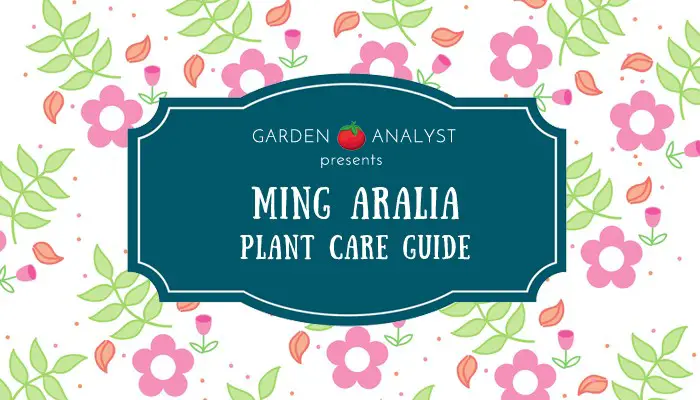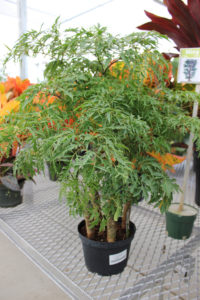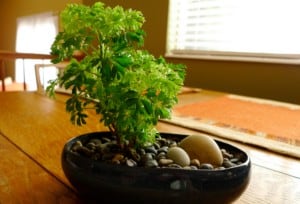Ming Aralia (Polyscias fruticosa) is a tropical plant domestic to Pacific Islands and it is prized both for is feathery foliage and its unusual and attractive form. In its native climate, it is grown outside, but there is no reason why you shouldn’t keep it as a houseplant. Learn how to properly grow this beautiful and exotic plant indoor and outdoors.


What Is The Ming Aralia Plant?
Ming Aralia, a perennial evergreen shrub, belongs to the family of Araliaceae and it has six varieties. Ming Aralia usually has a dark green, rich foliage, and the leaves tend to vary with shapes creating a ‘fussy’ but elegant look. Unlike many plants that branch sideways the Ming Aralia grows vertically, it has a straight-growing habit and it can reach up to 3-7 ft height.
You can grow it indoor, but in warmer climates, Ming Aralia makes a lovely and exotic outdoor shrub. And best of all – it is perfect for a bonsai!
Caring For Your Ming Aralia
Fortunately, growing Ming Aralia indoor as a houseplant is quite easy since the plant is highly adaptable to most homes. Here are useful advice and tips on how to take care of this impressive plant.
- Light: Ming Aralia is a quite tolerant plant – it can grow in partial light and low-light conditions, or even in the windows facing north, but it will grow more compactly under bright light conditions. Avoid mid-day sun and direct sun exposures, especially if it is grown outside. Ming Aralia loves morning sunlight.
- Temperature: It is a tropical plant, thus need warm conditions. Don’t expose the plant to air temperature below 60°F. The plant is also intolerant to extreme temperature shifts.
- Soil and fertilizing: This plant requires well-drained potting soil. Soil with some kind of organic material (pine bark, sphagnum peat moss) and a bit of perlite or vermiculite will provide an ideal drainage for the plant. It likes a slightly acidic soil, so ideal pH value for Ming Aralia ranges from 6.0 to 6.5. When fertilizer isn’t included in potting mix, feed your plant 2-3 times a year from March to October with a dilute mixture of water-soluble fertilizer. Don’t fertilize it during cold months when days are short.
- Watering: Water Ming Aralia thoroughly and let the soil slightly dry out before you water it again. Don’t let the soil dry out completely, but don’t overwater it! Ming Aralia likes humidity and soil that is constantly a slightly moist. Always remove the excess water from drainage saucer.
- Repotting: Ming Aralia doesn’t mind being slightly pot-bound since it grows best when the roots are confined. Taller plants need a heavier, steady container. You can repot it annually (in spring) or once in two years to provide the plant with rich, nutritive soil.
- Propagation: Propagating Ming Aralia is easy. You should propagate it during summer, using trimmings, stem tip cuttings or root cuttings, or grow it from the seeds in the fall or spring.
Propagation from root cuttings should be done in the early fall. Gather 4 to 6 inch long wooden cuttings with leaves from the base of a healthy, mature Ming Aralia. Use a sanitized knife to cut through the pale portion of the Ming Aralia to expose the inner flesh.
If you use softwood, green cuttings, take them from the top of the plant. Remove the lower leaves from the stem.
It is recommended to soak bottom part of cuttings into hormone rooting powder before you place them in the moist soil.
Make sure the pot with cuttings stays in a warm place, but out of direct sunlight. For better results, you can cover it with a plastic bag to provide the plant required humidity. It usually takes 4 or 5 weeks for the cuttings to grow enough roots to be stable, and then you can transplant them into a permanent container or into the garden.
- Pruning and styling: It is recommended to prune Ming Aralia during cold months – this way you’ll avoid making damage to the plant since the growing is quite reduced. If you want your Ming Aralia to be thick with a dense covering of leaves, you should trim the tips to encourage more rapid branching. Prune it to control its upright habit. Mastering the pruning of Aralias can result in stunning and elegant plant’s shape.

Growing Ming Aralia Bonsai
Aralia plants can be trimmed into a lovely bonsai specimens, but Ming Aralia is prized as one of the best and the finest plants for the bonsai. Though it grows vertically, a proper trimming can keep the plant at 1 ft tall, or even less. Growing bonsai isn’t easy, so make sure you do a good research on how to maintain the Ming Aralia bonsai.
Ming Aralia has a soft, delicate branches, so it’s better option to prune it to desired shape instead of wiring it. Pruning of inner branches will make Ming Aralia a more tree-like. Eventually, the lower branches die, and the plant’s trunk becomes bumpy and rugged.
You can always start your own Ming Aralia bonsai out of cuttings and continue with a proper pruning. You can also buy a pre-bonsai tree or a ming aralia stump with just a few branches in nursery and start your bonsai, making an ordinary stump into an extraordinary bonsai.
Fixing Common Issues with Ming Aralia
With proper environmental conditions, issues with the Ming Aralia are rare. It is rarely bothered by insects and pests, but some of the usual pests are aphids, scale, and spider mites. If you notice any of these, you can easily control them with Neem oil. Spray the plant with the mixture of 2 tablespoons of Neem oil and 1 gallon of water.
A common problem with the Ming Aralia is yellowing leaves. Yellow and brownish leaves can be caused by a lack of nutrients, so consider repotting the plant or fertilize it more frequently. A sudden temperature drafts, temperature extremes and overwatering may be the reason for yellowing leaves, too.
Dry air and low humidity can cause a leaf dropping. But, the dropping is usually a part of the normal growth. If there are plenty of new growing leaves at the stems’ tips, you don’t have to worry.
Every home has a different humidity, temperature and light conditions, thus it is important to carefully observe your plant’s growth and ‘behavior’ – that is the best way to learn what suits best for your plant.